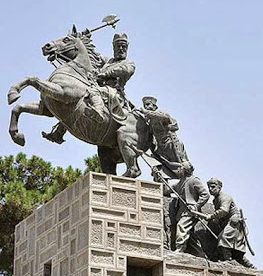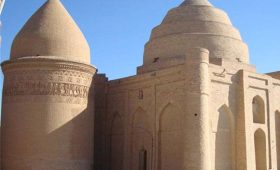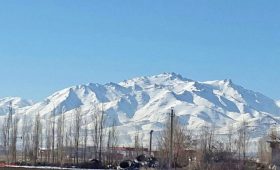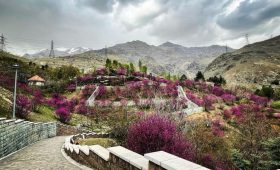Mashhad is one of the most important religious tourism destinations in Iran and the world, and therefore, a trip to Mashhad is considered one of the most popular pilgrimage trips among Iranians and Shiites. But the tourist attractions of Mashhad, in addition to the Holy Shrine of the 8th Imam (AS), include a wide and diverse range. One of the most important historical and touristic places in Mashhad is Nadershah Afshar ‘s Mausoleum, Jahangeshai Sharq.
The magnificent architecture of Nader Shah’s tomb on the one hand and Naderi Museum on the other hand has turned this complex into one of Mashhad’s tourist attractions. The building of the museum has an interesting architecture and historical and valuable objects such as weapons and weapons are displayed in the museum.
After the extinction of the Safavid dynasty and the dominance of Mahmud Afghan and Ashraf Afghan over Iran, Nader Shah Afshar (1100 to 1160 A.H.), who was also called “the last explorer of the East”, “Napoleon of Iran” and “Alexander II” in Europe, came from the region. Khorasan rose up and was able to suppress the local claimants, the Afghans and the Ottoman Empire. Then he organized a meeting in the Moghan plain and called himself the king of Iran.
Nadershah Afshar, who chose Mashhad as the capital of Iran for the first time, built his first tomb in this city in 1143-5. After he officially became the king of Iran in 1148 lunar year, he immediately set out to conquer India, when he returned from this trip full of loot, he decided to build another tomb for himself in this city.
Therefore, he ordered to bring large black marble stones from Dekhwar Khan, Azerbaijan to Khorasan. Some of these stones weighed between 20 and 60 kharvars, and their transportation was very expensive. For this reason, three pieces of these massive stones were called “Iran Kharab”, “Alam Kharab” and “Kharaj Alam”.
Finally, in the last years of his life, he built another building as a family tomb, that was called Khurshid Mansion, but his body was not buried in any of these three tombs. Sir Nadershah Afshar was sent from Quchan to Herat after his murder in 1160. His headless body was also temporarily buried in one of these tombs, but later Agha Mohammad Khan Qajar moved it to Tehran.
For this reason, Nader Shah did not have a tomb in the city of Mashhad for a long time until Qavam al-Sultaneh built a new tomb for him at the end of the Qajar period, i.e. in 1296, on the site of one of the three destroyed Naderi tombs, and his bones were moved there from Tehran.
The current tomb of Nadershah Afshar is built in a garden with an area of 14,400 square meters. The main building of the tomb has an area of 12,000 square meters and consists of four parts; Hall, the main space of the tomb. There are 16 solid stone pillars around the tomb. The ceiling of the tomb is more than 6 meters high. In this tomb, there is a twelve-step platform, a grave, a tent-like covering over the grave, a high platform next to the grave with the statue of Nadershah Afshar on a horse with three others who are following him, two halls as a museum, one to display the weapons of Nader Shah’s reign. And the other one is for displaying rare prehistoric weapons.
The design of the building is based on square and triangle shapes. The square-shaped hall consists of two red stone walls, closed and open in the columned part, and the rare tombstone is located in the corner of this square under the shelter of the two walls. The open space of the hall is a scene of war, defense and attack, and the red color of the two walls means war. The design of the columns around the hall evokes a rare hat. The materials of this building are rough and hard granite rocks of Mashhad.
The covering of the tomb is basically representative and reminiscent of the nomads’ tent; That is, the place where Nader’s life both began and ended.
The designer of the building was engineer Hoshang Sihoun and the sculptures were made by the late artist Abolhassan Sedighi.
Hall No. 1 is dedicated to all kinds of weapons from the Afsharia period, horse riding equipment such as saddles and bridles from the Afsharia period to the Qajar period, several manuscripts including the history of Naderi’s discovery of the world and two swords belonging to Nader, and its walls are decorated with paintings of Nader’s battle scenes in the Karnal War. The work of Seyyed Hossein Mir Mosvar is decorated.
Hall No. 2 of this hall was added to the collection in 1373 and it displays all kinds of coins, ancient and anthropological objects, dishes and other donated objects from the Safavid period to the present day. In addition to the objects inside the museum, the entrance to the main hall is also decorated with war cannons. Nader Tomb Museum is affiliated to Khorasan Cultural Heritage Organization.
One of the special features of this building is the design of aqueducts, ponds and streams, all of which are designed based on Iranian gardens, as well as walls with granite stones and iron fences in the form of Tabrizin. The Kharai of Mashhad pointed out with large pieces that symbolize the strength and majesty of Nadershah Afshar.




